Key findings
- Short-termism in marketing is undermining effectiveness - it boosts ROI but not profit growth
- Reach, scale and emotion are vital ingredients in effectiveness
- Adding TV to an ad campaign increases effectiveness by 40%, making it the most effective medium
- TV is the best for generating top-line growth that drives profit, with a 2.6% average market share point gained per year when using TV
- TV advertising is getting more effective, thanks in part to the internet
- TV and online video work in synergy, the most effective campaigns use both
The advertising world is changing – and the direction of travel is towards audio-visual. And landmark new research by the IPA revealed that TV advertising works best of all, especially when used in combination with online video.
In the world of marketing effectiveness research, two people stand above all others: Les Binet and Peter Field. In 2007, they published their first seminal meta-analysis of the IPA’s Databank, ‘Marketing in the Era of Accountability’, to identify which media strategies performed the most effectively at driving business effects such as profit growth and market share increases. The Databank contains every IPA Effectiveness Awards paper submitted since 1980 and as such, this was the largest and most thorough effectiveness study of its kind.
Fast forward nearly a decade, and Binet and Field have revealed their latest analysis of the IPA Databank, ‘Effectiveness in the Digital Era: Media in Focus’, which is designed to identify marketing best-practice at a time when usage of online channels is widespread. As stage one of four separate analyses, this work sheds plenty of new light on the effectiveness of advertising and the role of different forms of video within it.
The first part of the report, Media in Focus, is now available from the IPA. It takes the changing media landscape as its focus and addresses, among others, the issues of: Does mass marketing still work? Is tight targeting now the most efficient approach? Is unpaid making paid media redundant? It also investigates the broader issues of budgeting, planning and reporting, and challenges the industry to reconsider approaches to efficiency, ROMI and measurement strategy.
Short-termism is rising & effectiveness is falling
Marketing works in two ways: sale activation and brand building; with both creating an uplift of sales versus the base, but doing so in very different ways.
Sales activation is very much about short-term gains with tightly targeted campaigns prompting consumers to do something at a certain point in time – and to do it quickly. They provide short and significant spikes in sales, but typically the effects tend to fade quickly and brands end up back where they started.
Brand building, on the other hand, is a much slower burn. These messages tend to be more broadly targeted and designed to drive a deeper, more emotional connection with a brand. For this reason, they are usually more memorable. Whilst the short-term effects of brand-building campaigns are more modest, the power is in the longer-term impact, where growth is driven steadily year on year.
The effects can be summarised visually, like this:
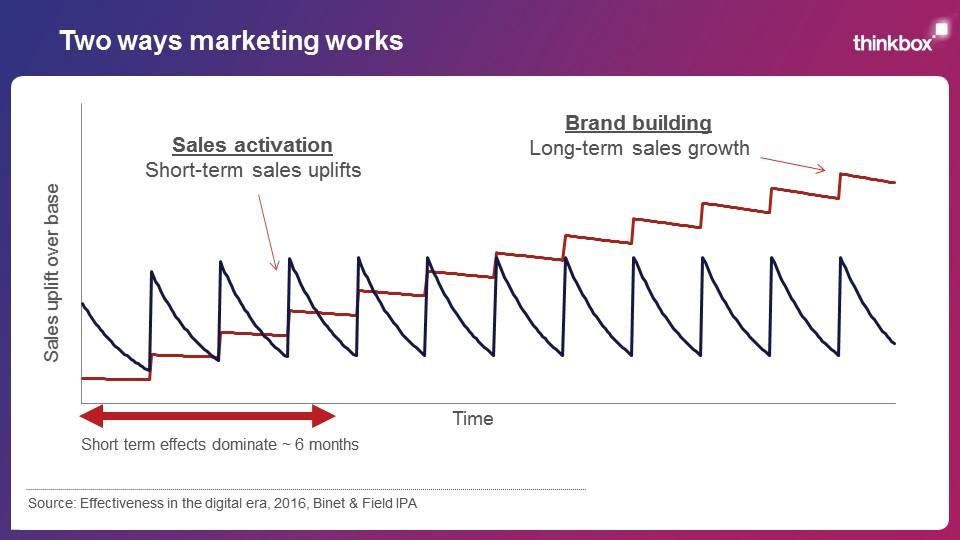
The issue that Binet and Field have identified is the real shift towards short-termism within marketing, to the detriment of brands. Back in 2011, a 60:40 ratio of brand building to activation was deemed optimum for business growth and success.
Move forward half a decade and the analysis worryingly revealed that around half of the case studies evaluated were based around short-term activation. By default, the short-term case studies tend to be less focused on profit and more centred on ROI.
This is important. Short-term campaigns can generate impressive sales spikes at relatively low levels of spend as they tend to focus on the online (non-video) channels which capture people when they are already in, or about to enter, the market. So they generate positive ROIs but to the detriment of long-term profit growth – which is exactly what marketing should be seeking to drive and exactly what brand building campaigns are designed to do. Worryingly, in a time where we should be reaping the rewards of our marketing knowledge and the expanded repertoire of channels at our disposal, Binet and Field have found that effectiveness is actually falling – and falling sharply. We’re focusing on short-term metrics and simply aren’t spending enough, in the right places, to really drive growth.
The learning? We need to refocus on profit rather than ROI and reflect that strategy in our media investment.
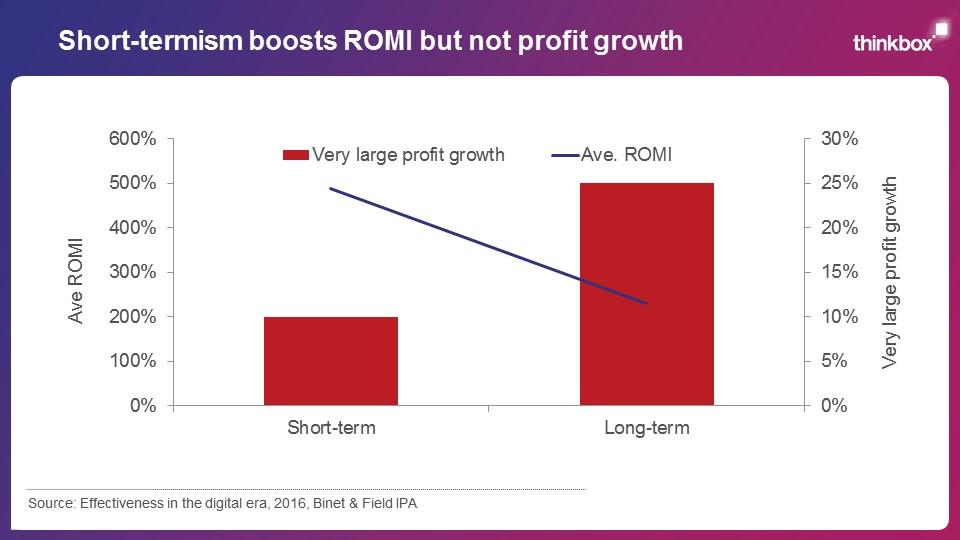
Mass media are crucial to driving growth
In a world of increasing personalisation, Binet and Field found that penetration is still three times more likely to be the main driver of growth and profit compared with loyalty. Scale of a medium is the primary driver of effectiveness.
Whilst tight targeting and loyalty are great for short-term efficiency, they are not strategies that build market share. In addition, ‘earned’ media cannot act as a substitute for investing in large-scale media channels. ‘Earned’ is simply a by-product of that investment. In fact, the further you spread your message and the more non-customers you reach, the bigger the brand effects.
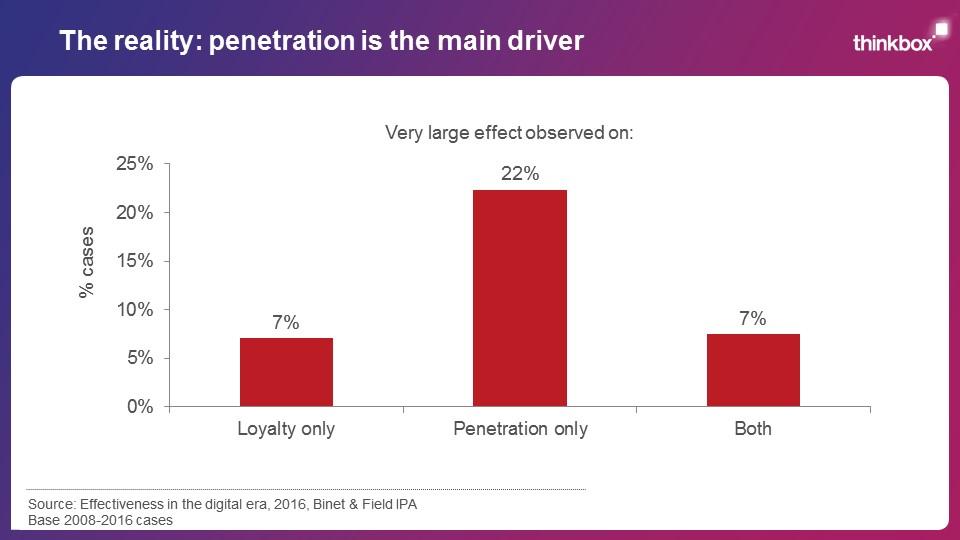
TV is the most effective medium
In particular, the findings reveal the impact of television. Investing in TV increases effectiveness by 40% - making it the most effective media channel. It is also the best for generating the top-line growth that is a key driver of profit, with a 2.6% average market share point gained per year when using television advertising.
One of the benefits of TV is that a huge numbers of people spend a lot of time watching it. Given that the primary driver of effectiveness is scale, TV outperforms at delivering increases in very large business effects, such as profit and market share. In addition, TV was found to be increasing in effectiveness over time. Between 1980 and 1996, adding TV to a campaign increased the very large business effects achieved by 12% on average. This increased to 40% during 2008-2016, which makes TV one of the biggest drivers of effectiveness overall.
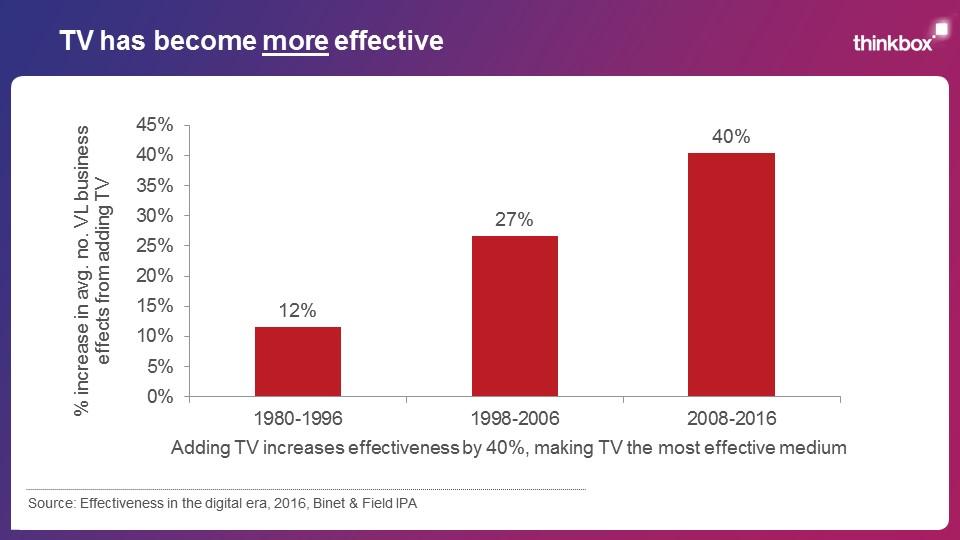
VoD boosts TV’s effectiveness
One of the reasons TV is becoming more effective is that it’s increasingly supported by on-demand formats, namely Broadcaster VOD and online video. BVOD can increase the effectiveness of TV by a third whilst other online video boosts its performance by c. 25%. But the power lies in combining both on-demand formats, with a 54% uplift in very large business effects when both BVOD and online video are used in conjunction with TV. This combination allows people to immerse themselves in the TV content. Moreover, emotional advertising, which Binet and Field found to be the most effective approach, is uniquely suited to video.
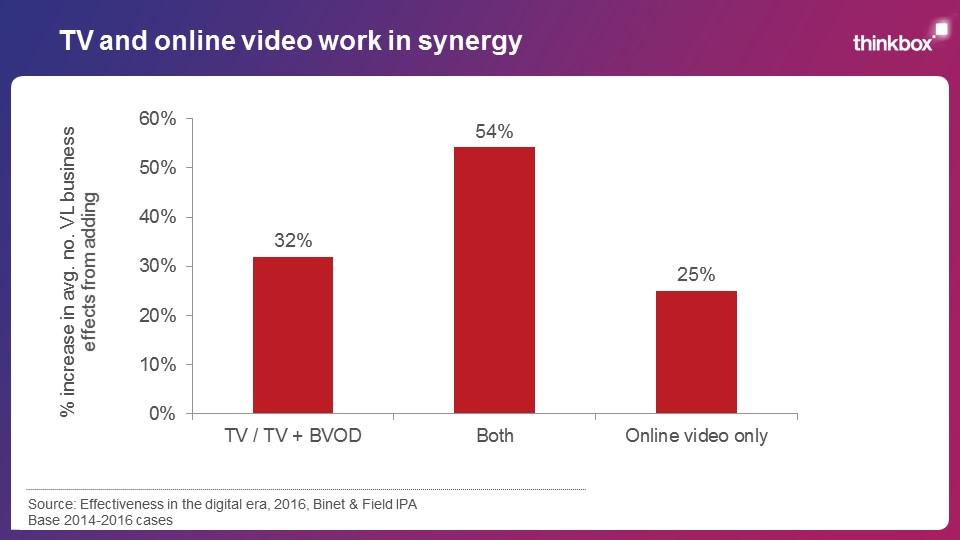
How to interpret the chart above
The IPA’s meta-analysis gives a very good steer on directional effectiveness – how many large business effects a channel contributes. However, it doesn’t tell us the volume of these individual effects (such as total profit) driven by any given channel. So, in interpreting the above chart, it would be correct to say that campaigns combining TV (inc VOD) and with online video contribute a greater number of very large business effects than a solus TV campaign. But it would be wrong to conclude that an online-only video campaign delivers 78% of TV’s volume of profit, or that the combination of TV and online video is nearly twice as powerful as TV alone.
When you think about the huge difference in scale offered by TV and online video as illustrated by IPA Touchpoints data and Thinkbox’s own video advertising analysis, you can quickly see that the volume of large business effects (such as total profit or market share) driven by TV relative to online video is going to be very different. The IPA’s helpful charts are directional, not proportional by volume. They tell you which pools you should be playing in, not how much.
In summary
As the custodian of brands, it’s our responsibility to see the bigger picture. Whilst the focus on short-term, activation marketing is profound given the prevalence of online channels – and the associated data those channels bring – we need to ensure that this doesn’t come at the expense of brand-building. Profitability and growth ultimately depend on being seen; there’s only so much you can derive from activation alone. Worryingly, the data suggests we’re now well beyond the optimum activation levels. All of this signals good news for mass media channels, but particularly for TV. TV is the most effective media channel and can not only drive the emotional connection needed to grow brands, but deliver it at volume.
 Thinkbox
Thinkbox